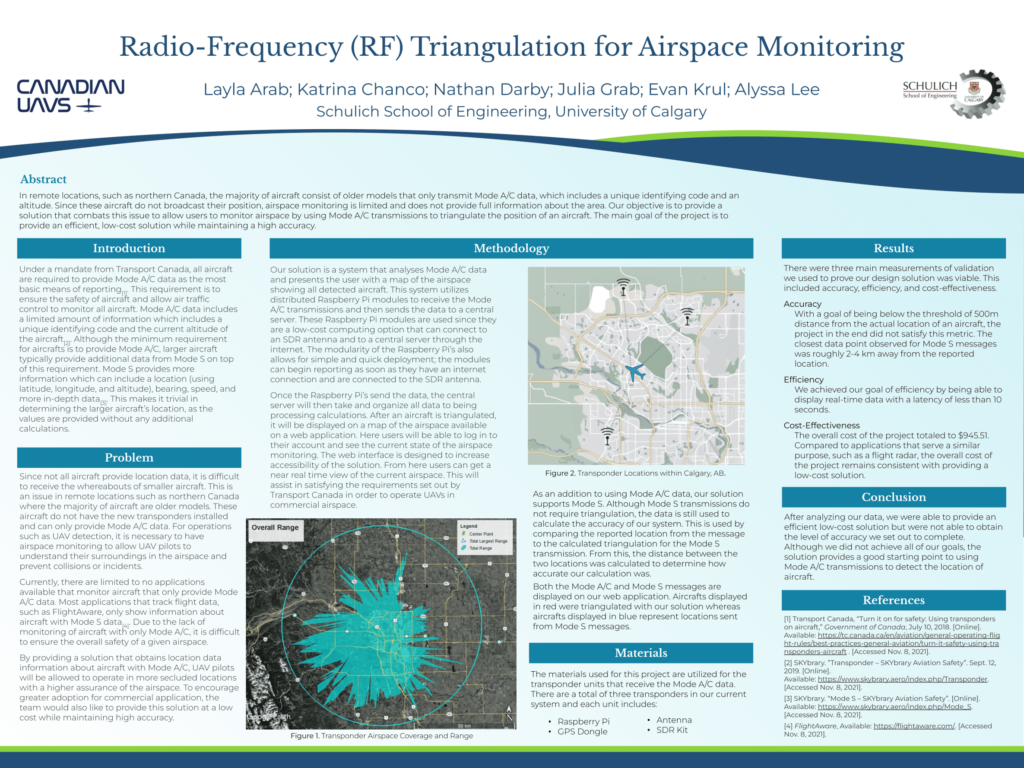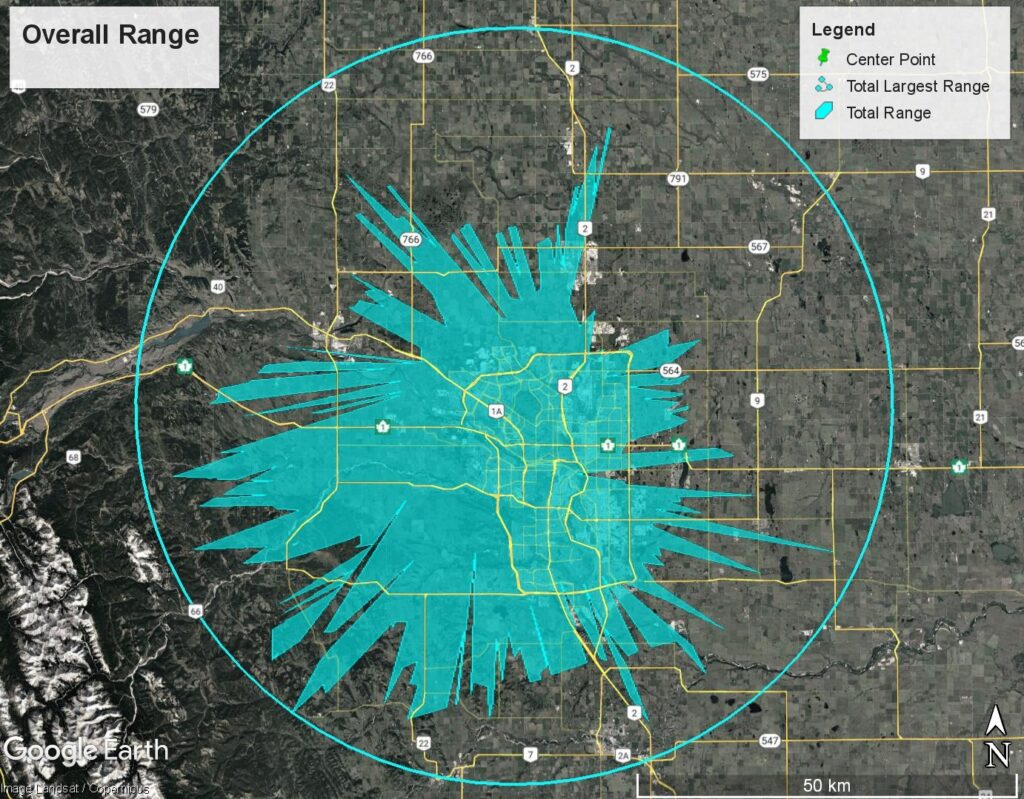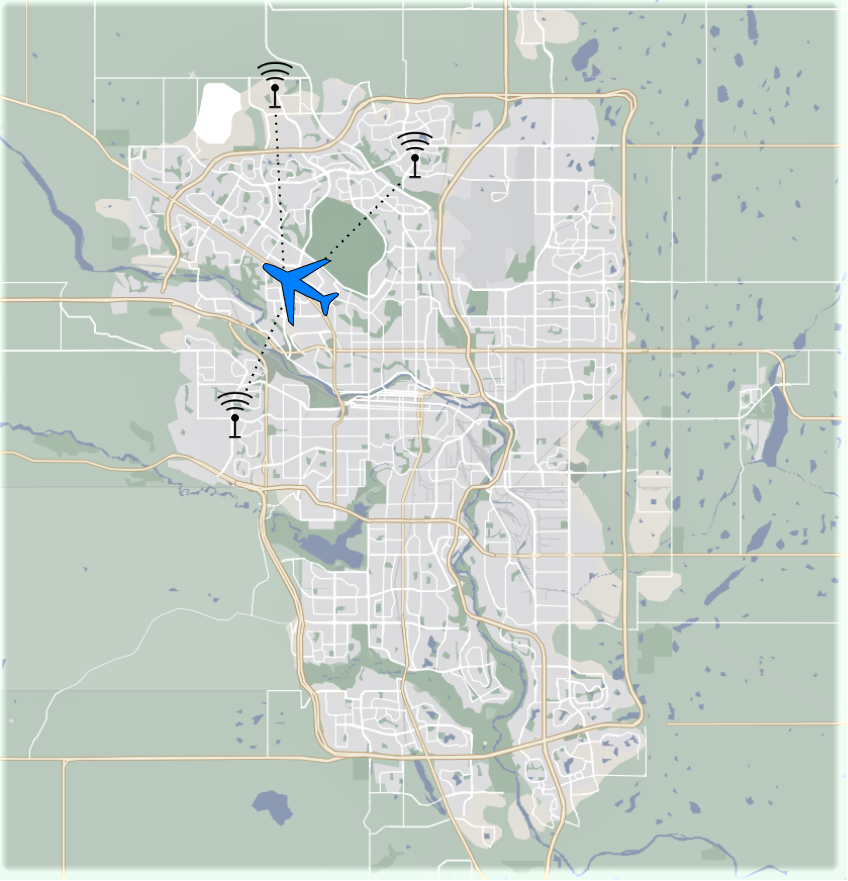Project Category: Software
Join Our Presentation on Tuesday, April 5th
Atrium CNRL Complex (Schulich School of Engineering) at Booth 19 in-person!
About Our Project
The unmanned industry is poised to make massive changes to the world from military operations to consumer drone delivery to automated drone surveying. The commercial applications of the UAV industry are estimated to be worth 27.4 billion USD by the end of 2021 and are projected to grow to 58.4 billion USD by 2026[1]. Commercially, UAVs are starting to see more and more applications in almost every industry. However, many challenges still remain that are preventing more widespread adoption in Canada.
Under a mandate from Transport Canada, all aircraft are required to provide Mode A/C data as the most basic means of reporting[2]. This requirement is to ensure the safety of aircraft and allow air traffic control to monitor all aircraft. Mode A/C data includes a limited amount of information which includes a unique identifying code and the current altitude of the aircraft[3]. Although the minimum requirement for aircrafts is to provide Mode A/C, larger aircraft typically provide additional data from Mode S on top of this requirement. Mode S provides more information which can include a location (using latitude, longitude, and altitude), bearing, speed, and more in-depth data[4]. This makes it trivial in determining the larger aircraft’s location, as the values are provided without any additional calculations.
However, since not all aircraft provide location data, it is difficult to receive the whereabouts of smaller aircraft. This is an issue in remote locations such as northern Canada where the majority of aircraft are older models. These aircraft do not have the new transponders installed and can only provide Mode A/C data. For operations such as UAV detection, it is necessary to have airspace monitoring to allow UAV pilots to understand their surroundings in the airspace and prevent collisions or incidents.
Currently, there are limited to no applications available that monitor aircraft that only provide Mode A/C data. Most applications that track flight data, such as FlightAware, only show information about aircraft with Mode S data[5]. Due to the lack of monitoring of aircraft with only Mode A/C, it is difficult to ensure the overall safety of a given airspace.
By providing a solution that obtains location data information about aircraft with Mode A/C, UAV pilots will be allowed to operate in more secluded locations with a higher assurance of the airspace. To encourage greater adoption for commercial application, the team would also like to provide this solution at a low cost while maintaining high accuracy.
The proposed solution to the problem above is a system that analyses Mode A/C data and presents the user with a map of the airspace showing all detected aircraft. The solution will utilize distributed Raspberry Pi modules to receive the Mode A/C transmissions and send the data to a central server. Raspberry Pi modules will be used since they are a low cost computing option that are able to connect to the SDR antenna and connect to a central server through the internet. The modularity of the Raspberry Pi’s also allows for simple and quick deployment; the modules can begin reporting as soon as they have an internet connection and are connected to the SDR antenna.
The central server will then take and organize all data, triangulating aircraft using the data received, to display a map of the airspace available on a web application. Here users will be able to log in to their account and see the current state of the airspace monitoring. The web interface is designed to increase accessibility of the solution, from here users can get a near real time view of the current airspace. This will assist in satisfying the requirements set out by Transport Canada in order to operate UAVs in commercial airspace.

Meet Our Team Members

About the Team: HighNoon
Layla Arab
Layla is a Software Engineering student in her fifth year of study. She completed a 12-month internship at Demonware where she worked on game services for titles such as Call of Duty, and a 4-month internship at Unity Technologies, where she worked on a Unity Ads analysis tool. She has a diverse skill set, including full stack development and graphics programming. She has a strong drive to optimize and simplify any task she sets her eyes on. Layla loves to compete in hackathons – she recently won first place in the Schulich Engineering Competition Senior Programming Division, the Western Engineering Competition Programming Division, and the Canadian Engineering Competition Programming Division.
Katrina Chanco
Katrina is in her fifth year of Software Engineering with a Minor in Economics. She completed a 16-month internship with Replicon as a Software Developer Intern and received the Intern of Merit Award. Her most recent accomplishments include placing first in the Senior Programming Division for the 2021 University of Calgary Schulich Engineering Competition, placing first in the Programming Division of the regional 2022 Western Engineering Competition, and placing first in the Programming Division of the national 2022 Canadian Engineering Competition. Katrina is also the President of the Engineering Students’ Society at the University of Calgary. It is her hope to combine her passion for software with her leadership abilities and pursue a career that utilizes both her technical and management skills.
Nathan Darby
Nathan is in his fifth year of Software Engineering at the University of Calgary. He recently completed a 16-month internship at Canadian UAVs where he was a key member that founded an internal management tool in less than a year and earned the Intern of Merit Award for his contributions. Outside of his studies he enjoys participating in coding competitions such as the Schulich Engineering Competition, Sr. Programming, where he has won 1st place for 3 years in a row and the Canadian Engineering Competition, where he won 1st place in the most recent competition. He has also been active in the Duke of Edinburgh and Scouting programs where he has been awarded the Duke of Edinburgh Gold Award and the Queens Venturer Award. In his free time he enjoys outdoor activities such as rock climbing and backpacking.
Julia Grab
Julia is currently in her fifth year of Software Engineering at the University of Calgary. She recently completed a 16-month internship at Canadian UAVs where she worked on the logic behind radars to provide data to an airspace monitoring system. From this internship, she received the Intern of Merit Award for her contributions. She currently works part-time as a Junior Software Developer at the same company. She is very keen in aerospace engineering but is also interested in exploring various aspects of the software community. During her spare time, Julia can typically be found painting, skiing, or hiking.
Evan Krul
Evan started his undergraduate software engineering degree in 2017. Coming from a technical background, he thrived in university. Evan loves working on writing ‘good’ code. Evan won first place in the Schulich Engineering Competition Senior Programming Division 2019, and also won in 2021. He continued on and won first place in the Western Engineering Competition Programming Division 2022 and the Canadian Engineering Competition Programming Division 2022. He works part time doing research work in distributed systems with Dr. Diwakar Krishnamurthy. He also finished a 16 month internship at Aimsio before coming back for his final year. Evan excels at architecture and design of systems.
Alyssa Lee
Alyssa is a fifth year Software Engineering student at the University of Calgary. She recently completed an internship at General Dynamics Mission Systems – Canada with the application infrastructure team where she worked on Windows applications and the middleware for networks and communication management. Alyssa is eager to realize her ideas through programming and apply her engineering knowledge in a practical setting. As the software team lead of the club Go Baby Go, she enjoys adapting ride-on toy cars for children with limited mobility. Outside of school, her interests include playing the piano, drawing, and hiking.
Details About Our Design
HOW OUR DESIGN ADDRESSES PRACTICAL ISSUES
In more remote locations where the majority of aircraft consist of older models, there is limited data received since most aircraft are only transmitting Mode A/C data. This can cause issues when using an airspace monitoring system that focuses on the data capture of Mode S messages. With our design, users have the ability to track aircraft in these more remote areas. This can be useful in situations such as inspecting pipelines in Northern Alberta.
WHAT MAKES OUR DESIGN INNOVATIVE
Current airspace monitoring applications are limited to only tracking aircraft that provide Mode S data. However, older aircraft that only provide the minimum Mode A/C information are not tracked, making it difficult to ensure full coverage and overall safety of the airspace. Our design stands out in its ability to track aircraft broadcasting either Mode S or Mode A/C data. Not only does our system provide real time tracking, but it also allows users to view historical flight data.
WHAT MAKES OUR DESIGN SOLUTION EFFECTIVE
Our design solution prioritizes the cost effectiveness, scalability, and simple presentation of the airspace monitoring application. The use of low cost materials makes our solution inexpensive and easily reproducible compared to other alternatives. The low cost and modularity of our solution also makes it very scalable and allows us to monitor large areas of airspace. Finally, the simple and interactive interface allows users to easily track flights through a live map view.
HOW WE VALIDATED OUR DESIGN SOLUTION
There were three main measurements of validation we used to prove our design solution was viable. This included accuracy, efficiency, and cost-effectiveness. Although we did not meet our goal of being accurate to within 200m, our solution did prove to be efficient and cost-effective. Our user interface displays aircraft from messages received within our goal of 10 seconds latency. As well, the overall project remains consistent with being a low-cost solution compared to other applications, such as a flight radar.
FEASIBILITY OF OUR DESIGN SOLUTION
Our solution as it stands currently needs improvement in order to make it successful and feasible. The main thing preventing the feasibility of the design is the accuracy of the timestamps from the SDR (Software Defined Radio) kits. In order to achieve the degree of accuracy the system requires, the timestamps need to be accurate to the nanosecond level. In order to achieve this, a custom SDR kit would need to be created that focuses on the accuracy of the timestamp of a received message. Further improvements to accuracy could be gained from increasing the precision of the multilateration algorithm.
Our design does well at being low cost and scalable; the requirements for latency and cost were met successfully. Thus, with further work to increase the accuracy of timestamps provided by the SDR kit our design is feasible.
Partners and Mentors
We would like to thank our partners and mentors who have guided us through this process and have given our team such amazing advice and support.
- Dr. Mohammad Moshirpour, Academic Advisor
- Zahra Kabirkhoo, Teaching Assistant
- Scot Rahal, Sponsor Representative
- Canadian UAVs, Sponsor Company
Our Photo Gallery



References
[1] “Unmanned Aerial Vehicle (UAV) Market”. Markets and Markets, June 2021. [Online]. Available: https://www.marketsandmarkets.com/Market-Reports/unmanned-aerial-vehicles-uav-market-662.html. [Accessed Nov. 8, 2021].
[2] Transport Canada, “Turn it on for safety: Using transponders on aircraft,” Government of Canada, July 10, 2018. [Online]. Available: https://tc.canada.ca/en/aviation/general-operating-flight-rules/best-practices-general-aviation/turn-it-safety-using-transponders-aircraft . [Accessed Nov. 8, 2021].
[3] SKYbrary. ”Transponder – SKYbrary Aviation Safety”. Sept. 12, 2019. [Online]. Available: https://www.skybrary.aero/index.php/Transponder. [Accessed Nov. 8, 2021].
[4] SKYbrary. “Mode S – SKYbrary Aviation Safety”. [Online]. Available: https://www.skybrary.aero/index.php/Mode_S. [Accessed Nov. 8, 2021].
[5] FlightAware, Available: https://flightaware.com/. [Accessed Nov. 8, 2021].
